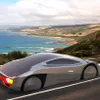Incredible photos of supersonic shock waves

These images will help engineers examine shockwaves on jets, the noise levels associated with them, and maybe even help reduce noise pollution.
With plans revealed for new super fast aircrafts by Airbus (dubbed Concord 2.0) and the German space agency (the SpaceLiner), it's clear that the world demands faster and faster transport. However, travel at this speed comes at a price - Malaysia banned Concorde from flying through its airspace amid public protests over the environmental impact of the sonic boom produced by supersonic travel. These new hypersonic crafts are planning avoid the issue by shooting around 30 kilometers (100,000 feet) into the atmosphere. But rather than fly higher, it would be much more convenient if noise could be reduced.
The photographs were taken using Schlieren imaging - a technique that visualizes changes in air density, in this case as a jet propels itself through the sky. When the density of air changes, its refractive index (ability to bend light) also varies. Schlieren photography isn't common, it is mostly used in aeronautical engineering since it beautifully maps the flow of air around objects. This makes it a fantastic tool for testing how aerodynamic a vehicle is.
The new images from NASA use this incredible technology to photograph airplanes in flight. The image to the right shows the air flow from a model airplane.

Scientists at NASA's Armstrong Flight Research Center and Ames Research Center have been working for the past five years to fine-tune this technique.
Taking the photos was a creative challenge on its own. A camera was strapped to the belly of a NASA Beechcraft B200 King Air. A second aircraft, traveling at supersonic speeds, then flies several thousand feet underneath it. This leaves the photographer a short window of time to capture the supersonic airflow.
Once successfully obtained, the final images must be processed before they can be analyzed. The Earth in the background needs to be removed, so the resulting image shows only the disturbances in the air. The process is dubbed AirBOS (Air background oriented schlieren).
The photographs provide the perfect diagram for researchers to help tweak future craft designs to reduce the noise production. “It is hoped that the AirBOS images can be used to validate or improve current design techniques,” explained Brett Pauer, CST project support manager at Armstrong. “In addition, this research technique may be used to validate design models of future prototype and demonstrator low-boom aircraft.”
There's lots of work to do before this leads to a quieter jet airliner; however, the aspiration is to lend these advances to commercial air transportation. Tom Jones, a project manager for CST, summed up their vision: “The end goal is to facilitate the ability for a new speed regime and open a new commercial market for civil transportation".
Tags:




